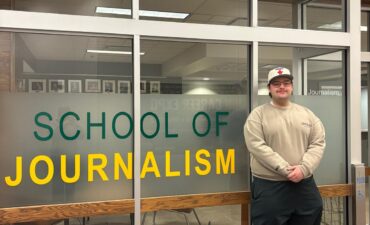Ridna Shkola, a community school in Regina, commemorated the victims of Holodomor with the support of the Ukrainian National Federation of Canada.

“It is important that our children remember this sad day because it is one of the pages in the history of the Ukrainian people,” said Svitlana Kenyuk, principal of Ridna Shkola.
In 1932-1933, Stalin’s totalitarian regime starved Ukrainians to death to suppress peasant resistance. People were deprived of everything and four million died of terrible hunger. Eighteen countries recognized Holodomor as genocide against Ukrainians and it has been commemorated for 88 years each Nov. 27.
A bronze figure, entitled “Bitter Memories of Childhood” by sculptor Petro Drozdowsky was placed in Wascana centre in 2015.It was erected in memory of Holodomor. In 2008, the Legislative Assembly of Saskatchewan recognized Holodomor as genocide against Ukrainians.
A moment of silence, spikelet, and lights marked the occasion. Students, teachers, and organizers of Ridna Shkola participated in this event.
“I was very happy to see many people at our event,” said Kenyuk
“This shows that people are not indifferent to each other. I hope that even more people will participate in our events.”
The children recited poems and sang songs about the victims of Holodomor. All guests joined the action of “light a candle” which is a symbol of memory of all those who died.
“I am glad that such events are held in Regina because it helps my children learn the history of their nation,” said Yana Okhrymenko, a guest at the concert whose son recited poems and sang songs with the other students.
“My children were born in Canada, so it is difficult to teach them the history of Ukraine. Such events best engrave the historical memory of their country.”
All participants of the event were dressed in Ukrainian traditional clothes. In the centre of the hall was a table with a lighted candle and a bunch of wheat spikelets. A spikelet is the wheat inflorescence that is characterized by an unbranched spike, where sessile spikelets are attached.
“Spikelets are a sad symbol of the Holodomor,” said Kenyuk.
Stalin’s regime began enforcing the Five Spikelets Act in 1932 to prevent people gathering food. Even a few spikelets of wheat collected without permission led to execution.
“I am happy that even in Canada people remember this tragedy and honour it,” said Okhrymenko.
The organizers also installed a floodlight that displayed videos with historical facts and photos of Holodomor.
“The purpose of this event is to tell children and adults about this terrible genocide against Ukrainians,” said Kenyuk.
“After all, there is no future without the past. Knowledge of history makes it possible not to repeat the same mistakes in the future.”
The UNF has held these events at the school since the 1980s. Every year there are more guests at the concert.
“We hope that our efforts will help to tell people and explain what the Holodomor is and why it is genocide against Ukrainians,” said Kenyuk.










